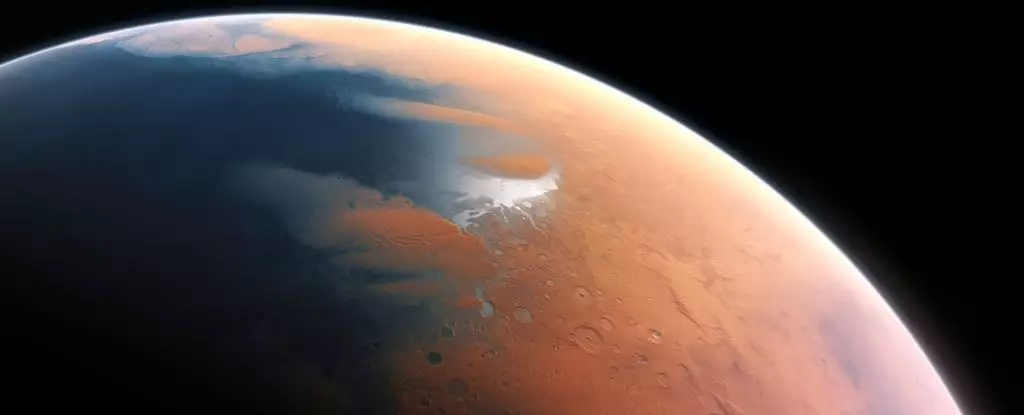Beneath the rusty surface of Mars lies a tantalizing secret that could transform our understanding of the Red Planet and its past. As we probe deeper into Martian geology, evidence increasingly points to a vast clandestine reservoir of liquid water lurking beneath layers of crust. For centuries, scientists have speculated about the presence of ancient bodies of water on Mars, but the ultimate fate of this water has remained an enigmatic puzzle, capturing the fascination of planetary scientists and amateur astronomers alike. Recent findings brought to light by NASA’s InSight mission could be the key to solving this riddle.
The Science Behind the Discovery
Through meticulous analysis of seismic data, researchers have discovered a noteworthy phenomenon: seismic waves slow down in a layer located between 5.4 and 8 kilometers beneath the Martian surface. This unusual slowing is likely indicative of liquid water, suggesting that beneath the extreme aridity of the Martian terrain, vital reservoirs may still be intact. This revelation accentuates that Mars, once a vibrant world bustling with rivers and lakes, has a far more complex history than its desolate exterior implies.
During the Noachian and Hesperian epochs, approximately 4.1 to 3 billion years ago, Mars teemed with flowing water and atmospheric conditions that would have supported potentially thriving ecosystems. However, as the planet’s magnetic field diminished and its atmosphere succumbed to the harshness of space, a significant portion of surface water either evaporated, froze, or was absorbed into minerals, leaving astrobiologists questioning the whereabouts of the “missing” water.
The Intriguing Hypothesis of Underground Aquifers
While some researchers have suggested that water might have seeped into the Martian crust during this planet’s tumultuous past, the true scale of the problem could be far more mysterious. Current calculations suggest that the “missing” water, if gathered from its hidden niches, could create an ocean at least 700 meters deep, perhaps reaching depths of 900 meters. The idea that this water might exist in aquifer-like layers underneath the surface adds a new dimension to Mars’ hydrological narrative: Could the planet harbor liquid water in a way akin to the aquifers found on Earth?
Evidence supporting this hypothesis has emerged not only from geological theories but also from practical analyses of seismic data collected by the InSight lander. Observations of “shear waves” generated by seismic activity caused by meteorite impacts revealed an underground anomaly that reflects a structure that could hold this precious resource. The data indicates a composition reminiscent of Earth’s own aquifers, composed of porous rock saturated with liquid water, akin to a sponge that retains vital moisture.
How Marsquake Data Illuminated the Mystery
In 2021, twin meteorite impacts and a subsequent marsquake in 2022 offered critical seismic data that would propel discovery. Using these seismic events as a focal point, scientists analyzed the resulting vibrational waves, which provided a wealth of information about the composition and structure of Mars’ crust. By capturing the high-frequency signals, researchers managed to draw parallels to Earth’s geophysical characteristics, revealing signatures that allowed them to infer the presence of water-laden rock layers beneath the surface.
This methodological approach resembles listening to echoes in a cavern; each bounce and reverberation assists researchers in tracing the hidden network of Martian geology. The revelation of an underground, water-saturated layer raises the tantalizing question of whether we are on the cusp of discovering ancient microbial life forms potentially preserved within these wetlands.
The Potential for Human Exploration and Scientific Discovery
The implications of finding such a substantial volume of liquid water extend beyond mere academic interest. Liquid water is an essential component for life as we know it, which ignites the debate around the potential for Martian life, whether past or present. Additionally, for future human explorers aiming to establish a sustainable presence on Mars, these underground reservoirs could provide not just drinking water, but a vital resource for generating oxygen and fuel for interplanetary travel.
However, ambitious plans would have to overcome significant challenges, including the technical hurdles associated with drilling deep into Martian soil. Moreover, concerns arise regarding contamination by Earth-based microorganisms, highlighting the need for stringent planetary protection protocols to preserve any unique Martian ecosystems that may exist.
A Call to Further Exploration
In light of these groundbreaking discoveries, the exploration of Mars is far from complete. The current data represents merely a snapshot of the planet’s potential life-sustaining capabilities. Future missions armed with advanced seismic instruments are crucial to uncovering other potential water reservoirs across Mars. This expanded exploration would not only refine our understanding of Martian geology but also inform our search for extraterrestrial life and provide insights into the evolution of planetary systems.
The discovery of these hidden reservoirs could fundamentally alter humanity’s relationship with Mars, beckoning us to reconsider the potential of the Red Planet as a stepping stone for future interstellar exploration. As we continue to unlock the secrets buried beneath the Martian surface, we are daring to redefine our understanding of life beyond Earth’s shores.

